 Whether it is the roar of the crowds in the stadium or just in your local gym or field we love to play like our heroes – the pros. Unfortunately, the downside is that sometimes our over zealous activity can lead to injury, either because we are new to it, we push beyond our limits, or through a simple accident.
Whether it is the roar of the crowds in the stadium or just in your local gym or field we love to play like our heroes – the pros. Unfortunately, the downside is that sometimes our over zealous activity can lead to injury, either because we are new to it, we push beyond our limits, or through a simple accident.
Injuries The Commonly Occur
The most common sports injuries occur to the ankles, knees, shoulders, elbows, and spine.
Broken bones can obviously occur when playing sport or exercising, but the more common injuries are those that happen to the muscles, tendons, and ligaments – the tendons attaching the muscles to the bones, and the ligaments attaching the bones to each other.
When you twist or overextend a joint, a strain can occur, which is a tear to the muscle or tendon, or a sprain can occur, which is a tear to the ligament. The damage these inflict varies in severity from a few torn or stretched fibers to a complete tear right through the structure. The latter will often require surgery to repair. Also susceptible to tearing are the intervertebral discs, which are the ligaments between the spinal vertebrae that act as shock absorbers. When this happens the disc will bulge and/or become herniated.
Over-training is a common cause of a condition called tendonitis, which is one of the so-called “overuse syndromes”. This happens when the joint is overworked and the connecting tendons become inflamed, causing pain and dysfunction. Stress or fatique fractures may also occur as a result of repetitive strain and activity.
The Exam and Common Treatments
Sports injuries are normally easy to diagnose because athletes have a heightened sense of physical awareness. A physical examination will often confirm the injury, but x-rays may also be ordered if the injury is suspected of being more serious, like a fracture.
TIPS
For minor injuries please follow these simple tips to help you recover faster:
Relax and Elevate: 48 hours rest and/or immobilization is normally enough, unless the injury is more severe. Too much rest can work against recovery in many cases, and can even be harmful. The sooner normal function is restored, the better, provided the process is not so hurried as to cause further damage through over-zealousness. Raising the injured limb above the level of the heart is thought to be helpful in reducing swelling. Your doctor of chiropractic can advise on the optimum times for rest and recuperation.
Ice: Ice can help to reduce the inflammation and speed healing.
Compression: Swelling may be controlled somewhat through compression of the injured area, as advised by your doctor of chiropractic.
Pain Relief: According to recent research, the use of certain nonsteroidal anti-inflammatory drugs should be limited as they may in fact retard the body’s natural healing process, causing a longer recuperation than necessary.
Joint manipulation: Recent research has also shown that joint manipulation, as practiced by your doctor of chiropractic, can help with certain types of injury, lowering pain levels and speeding recovery.
Being Proactive: Many sports injuries are preventable through the use of proper physical conditioning, including warm-up and cool-down routines, and correct techniques when practicing the activity. It may also be the case that safety equipment is available for your particular sport or exercise which will help lower the chances of injury. Keeping hydrated with a good intake of water also guards against injuries by feeding the tissues what they most require to function optimally.
Join the Team
As many of the top athletes know, being the top 1% includes having regular chiropractic care. Having their body in optimal health and alignment allows them to achieve optimal results.
Our expert team and practice has been designed with that premise in mind. To play like a pro you must train, heal, and recover like a pro for maximized potential and ultimate success.
For Your Health,
Dr. Frederick Savard

